Hello! This is Everything Is Amazing, a newsletter about curiosity, science, attention, wonder, and how to climb out of your Chasm of Ughh.
And thanks to a mysterious deluge of new readers over the last week, there are now over 8,800 of us! That’s both delightful, for which I’m very grateful - and terrifying, for which I’m, well, terrified. If I was trying to address you all in one big room, can you imagine how loud the heckling would be? Blimey. But no, I get to hide behind Substack and keep my introvertive imposter syndrome to myself. Tech is great sometimes.
(But since it’s also really nice to meet people in person, a few days ago I went to Glasgow to cross paths with comedy writer, unstoppable cyclist and interested-in-everything person David Charles, author of a superbly curious newsletter bearing his name. This virtual internet lark is all very well, but nothing beats some in-person conversation, good tea and the flinging of increasingly deranged creative ideas around for the hell of it. Never miss the opportunity to hang out in a cafe with someone whose brain you admire - the future You will always thank you for it.)
So, to things. Today, we’re returning to the big theme of this season of Everything Is Amazing: the more than two-thirds of our planet that we land-obsessed creatures have a habit of tuning out.
In that opener, I quoted oceanographer Gene Feldman: “…in the ocean, life is found all the way from the surface to the very bottom of the deepest part. The deepest part of the ocean is nearly seven-and-a-half miles down. Because of this, the oceans contain 99 percent of the living space on the planet.”
But then a very kind reader - thanks, Alex! - pointed me towards this study of the biomass (living material) distribution across our planet. It notes that terrestrial biomass seems to massively outweigh that in the oceans, despite the latter far more massively exceeding the potential living space available on land.
In short: if you stick to raw geography and surface area, our planet should indeed be called “Ocean”. But if you’re more interested in its lifeforms, a more representative name is the one we already use - “Earth.”
But hey, what if humanity decided to rebalance things, by moving itself into the ocean deeps? How would that go?
Here’s a videogame that answers “Uh - not well?”
In the 2007 videogame Bioshock, your mysterious protagonist survives a plane crash in the middle of the Atlantic in the 1960s by swimming to a nearby tower - which reveals itself to be the gateway to a ruined underwater city.
The city of Rapture is a beautiful thing wrought of unhinged megalomania - the work of Andrew Ryan, a businessman with a dream of creating a paradise of freedom and prosperity with no connections to the fickle modern world that repulsed him so much. (It’s no coincidence his name is a part-anagram of “Ayn Rand.”)
In doing so, he creates a place with no checks or balances on anything whatsoever - which, in the manner of such things, quickly becomes a chaotic nightmare.
Bioshock’s Rapture is one of the greatest inventions in videogame history, with an extraordinary sense of place that’s both giddily expansive and nerve-shreddingly claustrophobic. The game involves fighting your way across the leaking, shattered ruins of Ryan’s city, a place at once strikingly lovely and horrifyingly bleak, somewhere between the best of Roaring Twenties Art Deco and the worst of any warzone, enlivened with bucketloads of Mad Science Gone Wrong and populated by survivors that were once human and are now…something else entirely.
It’s an intoxicating creation, and the gaming world went nuts over it. Who wouldn’t be fascinated with such a place?
And that leads to the inevitable thought: hey, what if someone actually built Rapture for real? Or, putting it another way: barring all the stuff that went wrong, is this how you build a city at the bottom of the sea?
Let’s find out.
First, the depth.
While much of the game’s promo material seems to emphasize the darkness of the surrounding sea in pictures of Rapture, if you play the game, you’ll see sunlight light dimly filtering down from the sea surface.
I’m not sure if it’s officially canon, but a lot of websites describe Rapture as sitting on the sea floor at a depth of 2,000 metres. But the amount of natural light reaching it says otherwise. It doesn’t just mean that the city’s less than 1,000 metres down, the point where it’s too deep for any amount of sunlight to make its way down - it also means it’s got to be pretty close to the surface, probably within a couple of hundred metres.
But all this is clear anyway, because of the architecture.
Look at the way Rapture’s buildings are shaped. They’re blocky, rectangular, everything we’re used to seeing in a land-based building. But there’s a good reason why bathyscapes and submersibles have rounded edges, if they’re not just spheres outright. Roundness is the best shape to deal with crushing pressure, by distributing that energy equally around that object’s surface: any hard angles, and you’ve got a point of weakness.
If Rapture was 2km down, it’d be sat in pitch darkness, and most of it would instantly implode - BANG.
Even if you have rounded buildings, at that depth their walls are going to have to be hugely thick. At 2,000 metres, the water’s at roughly 200 times normal atmospheric pressure - and every square inch of a building has just over a ton of force pushing against it. Any weakness and the walls would explode inwards, and everyone inside would spill their expensive cocktails and then quickly cease to exist.
(Fun fact: if you head in the other direction, from sea-level into the vacuum of space, pressure isn’t such a big deal - because the force exterted is still only that of about 1 Atmosphere, just exerted in the opposite direction. For this reason, the walls of the Apollo Lunar Module - the only crewed space vehicle to land anywhere beyond Earth - were around the same thickness as the side of a can of Coke.)
Of course, in the wondrous world of Bioshock, maybe they’ve invented a construction material that can look sensational under any amount of pressure - the Harry Styles of rebar, let’s say. We’ll give them that much. But the presence of sunlight? Nah. Rapture has to be in the shallows - and indeed, as deep-sea biologist Andrew Thaler concluded on his blog Southern Fried Science, the city’s apparent location (a little off Iceland, where the sea-bed’s still relatively shallow) backs this up.
(Another clue: the design of the “Big Daddy” steampunk-style monsters lumbering their way around Rapture is based on US Navy diving suits of the 1930s & ‘40s - and they had a depth limit of 150m.)
So, this is a city less than 200 metres below the waves. That feels a lot more doable.
Something the crumbling Rapture of Bioshock still has going for it is power. All the lights are on, the billboards are still flashing away, and there’s presumably just enough heating to keep its hideous, violent occupants alive so they can continue to war with each other until the bitter end. (*Resists the urge to make a joke about social media*)
Where is this energy coming from? The game answers this: it’s hydrothermal. And the city itself rests at the edge of a great chasm. If you remember my recent two-parter about the Mid-Atlantic Trench, it’s not hard to put the pieces together. Rapture is trench-powered, independent of fossil fuels - an eco-friendly living horror! (Note to all our current governments: when even our darkest gonzo-science loonfest fictional dystopias are doing better things for the planet than you are, maybe you could step your efforts up a notch?)
Okay. I’ve talked enough about Bioshock. After all, this is a game that ends with you defeating a gigantic blue-skinned fake Irishman by firing lightning at him from your fingertips (oh come on, we’ve all been there). It’s not exactly what you would call peer-reviewed when it comes to the facts, unless all those peers are mad scientists…
So what about living down there for real?
In 1965, Colin Irwin, a 19 year-old from Bournemouth (England), decided he wanted to live in a steel tank weighed down with sections of railway line at the bottom of the sea for a week.
This may sound like the beginning of a winning entry for the Darwin Awards, but perhaps unlike most 19 year-olds, Irwin knew precisely what he was doing. As the Science Officer of the Bournemouth and Poole Sub-Aqua Club - still going strong today - and inspired by the Conshelf expeditions of Jacques Cousteau, he raked together £2,000 to build an undersea habitat, and recruited fellow club member John Heath (21) to accompany him on a week-long experiment into, let’s face it, the human limits of self-inflicted misery.
Once built in a friend’s shipyard, the habitat was dropped 11 metres under the waves to the bottom of the Plymouth Sound - and Irwin & Heath followed it:
“Living conditions in the habitat must have been very rough. The temperature was around 16 degrees with almost 100% humidity. The huge amount of condensation meant that keeping anything dry was nigh on impossible. Food and drink were brought down in army pressure cookers, so even the meals must have been a bit of a disappointment.”
Even more remarkably, since they couldn’t afford the expensive oxygen feed-lines that Cousteau had been using in his undersea habitats, they simply didn’t bother having any:
"We had to analyse the atmosphere, see what the oxygen level was, what the carbon dioxide level was and put out soda lime to absorb the CO2 and top it up with oxygen bottles. So by virtue of economics, we became the first underwater home with a self-contained atmosphere."
- “An act of extraordinary, underwater DIY,” Dave McMullan, BBC News
(Today, the small number of currently running underwater habitats use a mixture of compressed air and an absorbant called SODASORB® to scrub a habitat’s air clean.)
If all that wasn’t undignified enough:
“Nipping out for a "number two" toilet break was something of a challenge. The aquanauts had to restrict themselves to only going every couple of days as they had to go through a hatch to a separate compartment, so their living area wouldn't get contaminated.”
If your idea of fun with science is desperately holding your poop in for days while breathing warm, wet air so stale you could cut it with a breadknife, I’m not sure we share similar goals in life.
Yet Irwin & Heath’s achievement is still remarkable. It showed that such a thing was possible without the usual specialist equipment, if you were willing to feel bad enough for long enough. But even at a depth of just 11 metres, the usual problems with underwater living made an appearance. In Irwin’s words:
"What was psychologically different about it was that normally if you get into trouble, you want to get up to the boat or dry land. But after we'd been down there 24 hours, we were on what's called a full saturation dive. Our fatty tissues were full of dissolved nitrogen. If we'd made an emergency ascent, we'd have got the bends."
This is where Bioshock - and every cheesy subaquatic action B-movie you’ve ever laughed your way through - betrays its fictional roots. Any time you see The Hero swimming up to the surface like a rocket, leaving their flooding/exploding/ententacled submersible behind them, spare a thought for the poor souls who tried that in real life before decompression sickness was fully understood.
It’s a thing of unspeakable agony - and in some cases, a death sentence.
This isn’t a trivial issue. Any city resting on the bed of the ocean at any depth would have to contend with the amount of time required for anyone leaving it to decompress. This isn’t going to be a case of “I’m going to lunch in Rapture and be back on the ship for dinner.” Once you’re down, you’re locked into a slow queue of physiological adjustments aided by technology - and if you try jumping it, you might die. No messing around.
(This extra time required to decompress, plus the required thickness of the habitat walls, puts a limit on how deep is practical for longterm living. Maybe 200-300 metres?)
But the pressurised nature of breathable habitat air carries another danger. Remember liquid breathing, from my newsletter a while back? It’s forcing your lungs to work harder than they ever do with sea-level air, which runs the risk of damaging them. Breathing higher-density air, with more oxygen per breath, could be putting similar strain on your circulatory system, more than it’s able to handle in the long run, leading to “pulmonary toxicity.” It’s not known how much of a problem this could be, because nobody’s stayed down long enough to find out, but - a city’s worth of people? That’s a lot of medical lawsuits if your estimates are off.
Other practical problems include:
What about your food? (Not too difficult to obtain if you like a lot of seafood - but cooking underwater can be a problem because of the way fumes linger in static air, and since your sense of taste appears to diminish in pressurised environments, this won’t be a fun place for gastronauts to hang out).
Infections? Ear infections are common on currently-operational habitats, and even a mild cold could play havoc in such a relatively confined space - so let’s not think about something like COVID-19?
Skin conditions? Not only would you be getting zero sunlight on your skin with all the problems that might entail - what about all the skin you shed? And diaper rash is common for divers spending a long time out in the water, because when you have to pee - well, there’s only one option. Oh dear.
Okay. The challenges are many. So here’s a question that maybe belongs right at the beginning of this essay: why the actual f*** would you put yourself or other human beings through all this?
The two biggest reasons for now are training and research. If you’re doing deep-sea research, it’s much more time-effective (and much less exhausting) to stay down there for days or a week at a time, instead of spending hours every day descending and resurfacing…
And since it’s an environment with a lot of similarities with outer space - like the way buoyancy is a big step closer to weightlessness - it’s a good place to train astronauts. For example, Chris Hadfield did some of his training in the Aquarius Underwater Laboratory, currently operating 18 metres down off the Florida Keys.
But in terms of settling or relocating large numbers of people - this is currently as practical as doing it off-world. It has nothing to do with solving any of the world’s population-density problems. It’s not going to create vast, welcoming havens, unless they’re for the super-rich and the super-masochistic. It’s certainly a branch of What-If science with a lot to teach about living in such difficult conditions - but it’s doubtful if we’ll ever have good reasons to live down there en-masse, fulltime. (Let’s hope not, because that would mean things are really bad up here.)
So here’s a better idea.
This is Lilypad, a project concept for a floating city housing 50,000 people. It’s probably the most famous of a number of proposals to send large amounts of people to sea - say, those made refugees by rising sea levels - on largely self-sustaining habitats.
This feels like a more fruitful way to use that other 71% of our planet. It’s still a formidable technical, economic and social challenge, which is perhaps why Lilypad’s blueprints have been knocking around since 2008 without any meaningful moves towards actually building one. But it now sits alongside many other proposals for floating settlements, and it only feels like a matter of time.
I particularly like this human-free ‘floating park’ idea to green urban coastlines and over-industrialised ports and harbours, nicknamed “Sea Tree.”
So, maybe it’s best we forget engineering our Raptures for now, and consider the deeps as places worthy of study, but not of mass-habitation.
But cities afloat, using everything we've learned about the oceans, and maybe doing something about cleaning them up in the process? That sounds like scifi well worth turning into fact.
Further reading:
“Will we ever live in underwater cities?” - Rachel Nuwer, BBC Future
Images: Nerdist; NASA; Colin Irwin/Submerged; Cristian Palmer

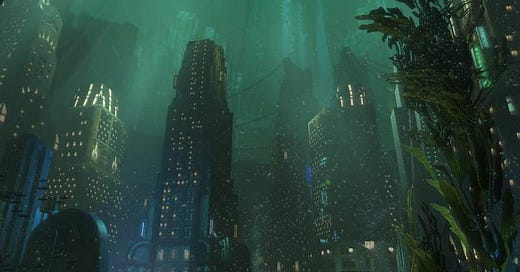


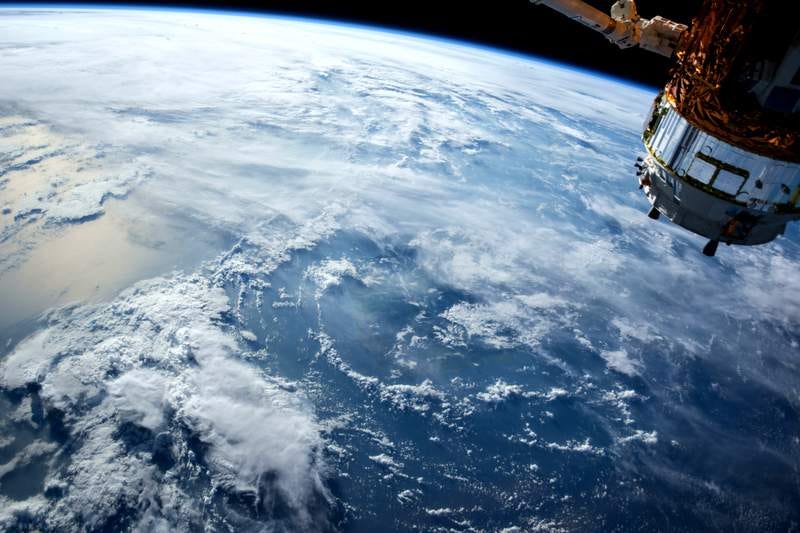

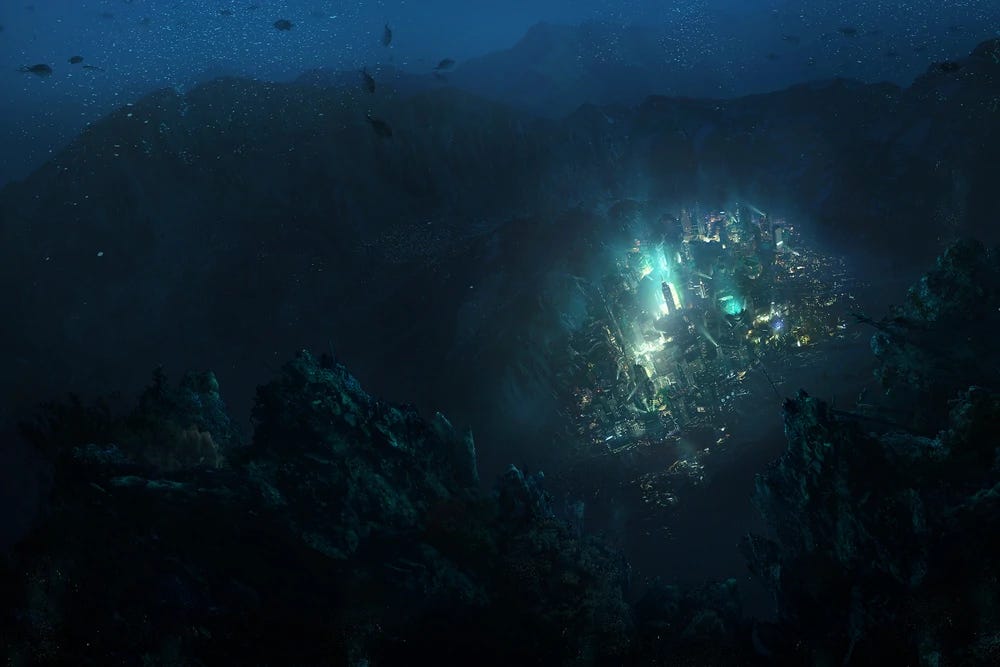

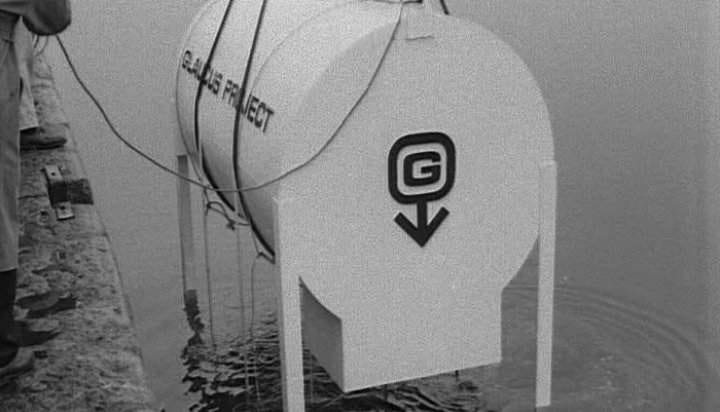
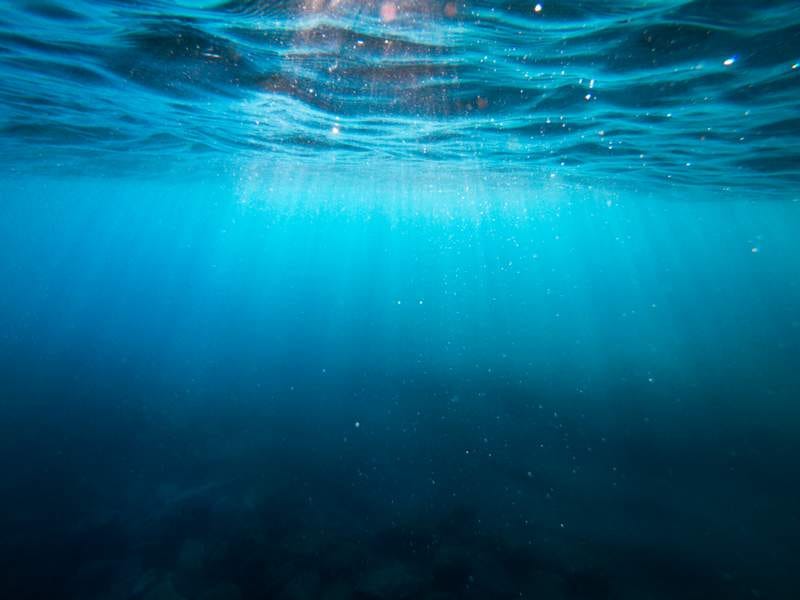
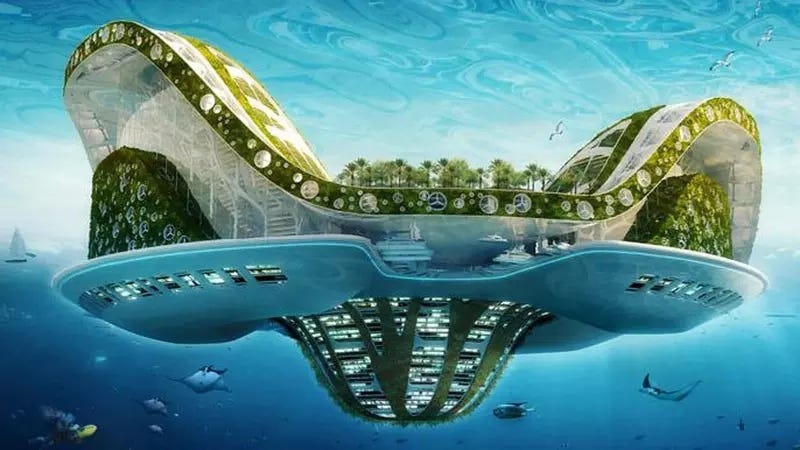
PLEASE DO NOT SEND THIS TO ELON MUSK.
8800! Wonderful! As usual, so interesting. I hope we get creative quickly because climate change is here and we are going to need some very creative solutions.